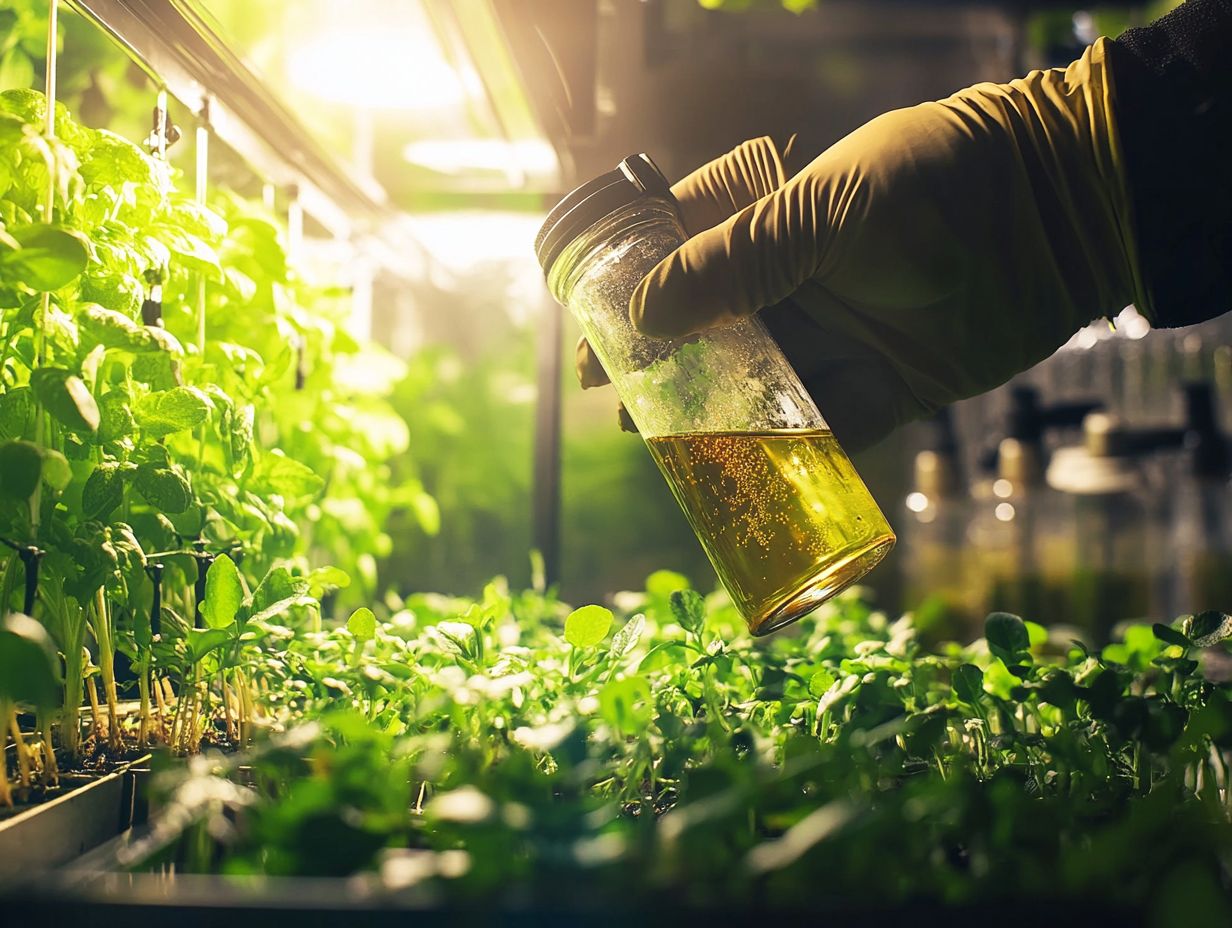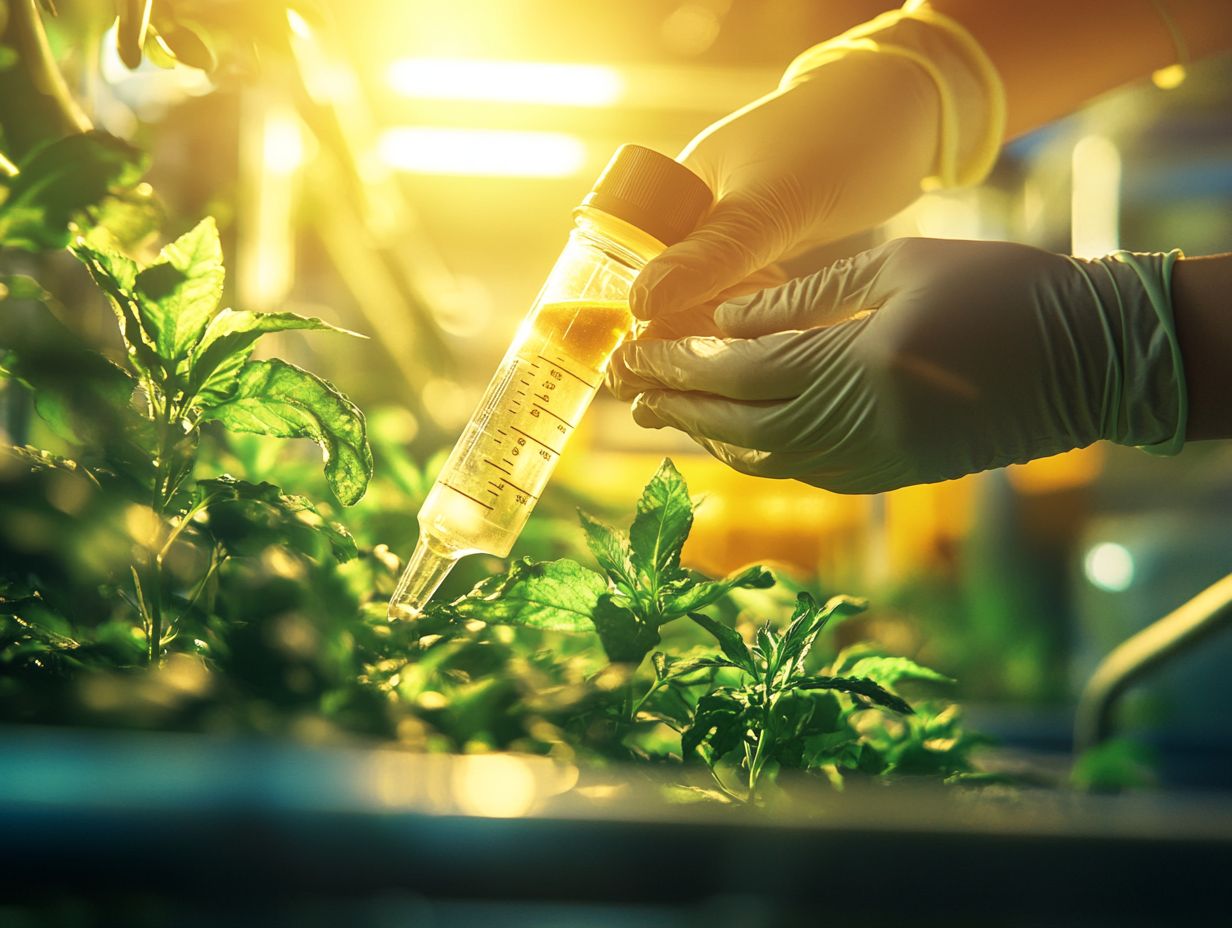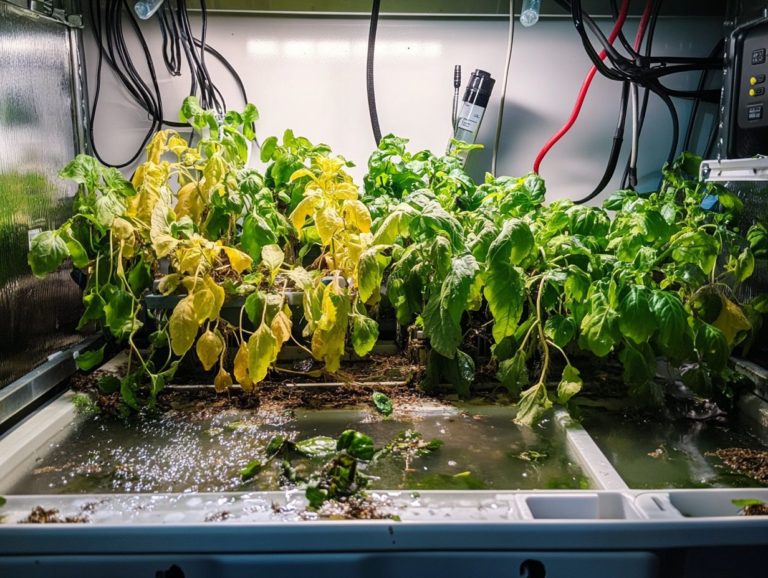How to Balance Nutrient Solutions in Hydroponics
In the realm of hydroponics, understanding the details of nutrient solutions is essential for nurturing robust plants.
This article explores the major nutrients needed in large amounts and minor nutrients needed in small amounts that are critical for growth. It examines key components and their specific functions, as well as factors influencing nutrient balance, including environmental conditions and the unique needs of different plants.
You will discover effective techniques for calculating and adjusting nutrient levels, troubleshoot common mistakes, and learn best practices for monitoring and maintaining nutrient health.
Dive into this essential knowledge and watch your plants thrive in their soilless environment.
Contents
- Key Takeaways:
- Essential Nutrients for Plant Growth
- Factors Affecting Nutrient Balance
- Methods for Balancing Nutrient Solutions
- Common Mistakes and How to Avoid Them
- Monitoring and Maintaining Nutrient Balance
- Frequently Asked Questions
- What is hydroponics and why is it important to balance nutrient solutions?
- How do I determine the right balance of nutrients for my hydroponic system?
- What are the essential nutrients for healthy plant growth in hydroponics?
- How often should I check and adjust the nutrient levels in my hydroponic system?
- What are some signs that my hydroponic plants may be lacking nutrients?
- Can using too much or too little nutrients harm my hydroponic plants?
Key Takeaways:

- To grow healthy plants in hydroponics, you need balanced nutrient solutions.
- Understanding key nutrients and environmental factors is crucial for maintaining proper nutrient balance.
- Regular monitoring, testing, and maintenance are necessary to avoid common mistakes and troubleshoot imbalances in hydroponic nutrient solutions.
What are Nutrient Solutions and Why are They Important?
Nutrient solutions are mixtures that provide the essential major and minor nutrients needed for optimal plant growth without soil. In urban farming, especially in Hydro-Gardens, these solutions ensure your plants receive a well-balanced diet rich in vital nutrients like nitrogen, phosphorus, and potassium, which are crucial for robust growth and productivity.
By understanding the composition and significance of nutrient solutions, you can prevent nutrient deficiencies, optimize water efficiency, and learn how to prevent nutrient burn in hydroponics, allowing you to sustainably produce high-quality crops.
Unlike traditional farming, where nutrients come from the earth, hydroponics relies on precisely formulated nutrient solutions that dissolve in water, making them readily available for quicker absorption. This fosters faster growth rates and higher yields in compact spaces ideal for urban environments.
Each component in your nutrient solution, whether it’s calcium for cell wall integrity or iron for chlorophyll production, plays a vital role in the overall health of your plants. This emphasizes the significance of well-formulated nutrient solution recipes.
As modern agriculture increasingly adopts sustainable practices, recognizing the value of these nutrient solutions is essential for tackling food security challenges and maximizing resource efficiency in densely populated areas, especially through methods used in urban farming.
Essential Nutrients for Plant Growth
Essential nutrients for plant growth can be classified into major nutrients and minor nutrients, each playing a pivotal role in the health and productivity of your plants, particularly in hydroponic systems.
Major nutrients such as Nitrogen, Phosphorus, Potassium, Calcium, and Magnesium are needed in larger quantities to support robust growth. In contrast, minor nutrients, including Zinc, Copper, Manganese, Boron, and Chlorine, are required in smaller amounts but are equally critical for various biochemical processes that keep your plants thriving.
Identifying and Understanding Key Nutrients
Identifying and understanding key nutrients is essential for your success in hydroponic farming. Each nutrient plays a distinct role in plant development. If you don t manage them properly, you risk nutrient deficiencies that can hinder growth. Macronutrients like nitrogen, phosphorus, and potassium are vital for growth, while micronutrients support various physiological functions and overall plant health.
Recognizing nutrient deficiencies or excesses helps your plants thrive. For example, yellowing leaves may indicate nitrogen deficiency, while burnt leaf tips could signal an excess of nutrients. Each nutrient contributes uniquely: nitrogen promotes vigorous leaf growth, phosphorus is crucial for root development and flowering, and potassium helps regulate water uptake and enzyme activation.
To maintain balanced nutrient solutions, regularly test and adjust your mixtures! Tailoring your recipes to specific crops will help you address deficiencies effectively. For more detailed guidance, refer to our resource on Understanding Hydroponic Nutrient Solutions. Monitor pH levels and adjust nutrient concentrations to prevent nutrient lockout, fostering a healthier growing environment for your plants.
Factors Affecting Nutrient Balance

Numerous factors influence nutrient balance in hydroponic systems. It is imperative to monitor both environmental conditions and the specific needs of your plants to achieve optimal growth.
Key elements such as pH levels and electrical conductivity the ability of a solution to conduct electricity, which helps indicate nutrient levels are crucial in determining nutrient availability. Additionally, environmental factors like temperature, humidity, and light significantly impact how effectively your plants absorb essential nutrients.
Environmental and Plant-Specific Considerations
Environmental and plant-specific considerations are crucial when crafting a balanced nutrient solution for your hydroponic system. Different species have varying nutrient needs to thrive. Factors like light intensity, temperature, and humidity play a significant role in determining these specific requirements, making the right nutrient composition essential for optimal growth.
Recognizing that light duration and quality can influence photosynthesis rates means you’ll need to adjust nutrient levels accordingly. For example, leafy greens thrive in cooler temperatures with lower nutrient concentrations, while fruiting plants like tomatoes flourish in warmer settings with richer hydroponic nutrient solutions.
Monitoring pH levels and electrical conductivity provides valuable insights into how effectively certain crops absorb nutrients. Fine-tune your approach based on each plant’s unique requirements. Consider the specific needs of your crops like basil’s craving for magnesium or cucumber’s affinity for potassium for better growth and optimized yield. You may also want to learn how to make your own hydroponic nutrient mix to tailor the nutrients to your plants’ needs.
Methods for Balancing Nutrient Solutions
Balancing nutrient solutions is essential for achieving success in hydroponic farming. Several well-regarded methods, such as the Modified Sonneveld Solution, offer a reliable framework for attaining this equilibrium by using components like calcium nitrate, potassium nitrate, ammonium nitrate, and magnesium sulfate.
By thoughtfully incorporating these key ingredients, you can cultivate an optimal environment for plant growth while minimizing the risk of nutrient deficiencies. To achieve this, consider learning how to mix hydroponic nutrients like a pro. This strategic approach ensures that your plants receive the support they need to thrive in a hydroponic system.
Calculating and Adjusting Nutrient Levels
Calculating and adjusting nutrient levels is an essential skill for someone who grows plants without soil. Maintaining the correct nutrient concentration is key to maximizing plant efficiency and health.
By utilizing tools to measure nutrient concentration and regularly testing your solutions, you can make precise adjustments that ensure optimal nutrient uptake and prevent deficiencies.
Start by selecting the right tools, such as a pH meter and an EC (electrical conductivity) meter, which measure how well your solution can conduct electricity, indicating nutrient concentration. Once you have your initial readings, refer to nutrient charts specific to the plants in your system. Additionally, understanding pH levels in hydroponic nutrients will help you determine the ideal nutrient ratios needed at various growth stages.
Regularly monitoring these levels allows you to intervene promptly when imbalances arise. Consider utilizing software or mobile apps that track your nutrient data; this can streamline the adjustment process and make it simpler to achieve and maintain a stable environment that promotes healthy plant growth. Additionally, understanding how to choose the right nutrient solution is crucial for optimal results.
Common Mistakes and How to Avoid Them

Common missteps in nutrient solution management can create nutrient imbalances that negatively impact plant health. As a grower, you must stay alert to these common pitfalls within hydroponic systems.
By addressing issues like incorrect pH levels, improper nutrient concentrations, and inadequate monitoring, you can sidestep costly mistakes and ensure your crops flourish.
Troubleshooting Nutrient Imbalances
Troubleshooting nutrient imbalances is crucial for you to maintain healthy plants in hydroponic systems. Signs of deficiency can show up in various ways, from leaf discoloration to stunted growth.
By identifying these symptoms early, you can effectively implement corrective measures and restore balance to your nutrient solutions.
Common indicators of nutrient deficiencies include yellowing leaves, which often suggest a lack of nitrogen, or browning leaf tips that may indicate potassium shortages. You might also notice excessive leaf drop and poor root development, which are typically signs of calcium or magnesium deficiencies.
To tackle these imbalances, start by analyzing your nutrient solutions and adjusting concentrations as needed. Incorporating supplements like chelated minerals can be a game-changer in restoring those deficiencies. Maintaining optimal pH levels and ensuring proper water oxygenation will enhance nutrient uptake.
Act quickly to correct nutrient imbalances! Your plants depend on it.
Monitoring and Maintaining Nutrient Balance
Monitoring and maintaining nutrient balance are essential practices for achieving success in hydroponic farming. By consistently overseeing these elements, you ensure that your plants receive the precise nutrients they need throughout their growth cycle.
Regular testing of nutrient solutions, pH levels, and electrical conductivity gives you the power to make timely adjustments, creating and sustaining optimal conditions for robust plant health.
Regular Maintenance and Testing Techniques
Regular maintenance and testing techniques are essential for ensuring the effectiveness of nutrient solutions in hydroponic systems. By mastering these practices, you can cultivate healthier plant growth.
Routinely monitoring pH levels and electrical conductivity allows you to keep your nutrient solutions balanced and effective, ensuring optimal plant nutrition.
To achieve this, it s advisable for you to adopt a systematic testing approach ideally on a weekly basis using calibrated pH meters and EC meters for precise readings.
When pH levels stray from the optimal range of 5.5 to 6.5, it can disrupt nutrient uptake, ultimately impacting plant health. Likewise, maintaining appropriate electrical conductivity levels guarantees that your plants receive the right concentration of nutrients. To ensure you’re achieving this, learn how to test nutrient levels in hydroponics, preventing deficiencies or toxicities.
By regularly assessing and adjusting these parameters, you can identify any imbalances early on, enabling proactive adjustments that significantly enhance yield quality and plant vitality.
Frequently Asked Questions

What is hydroponics and why is it important to balance nutrient solutions?
Hydroponics is a way to grow plants without soil. Instead, it uses a nutrient-rich water solution to help your plants thrive.
Balancing nutrient solutions is key to your plants’ success! It ensures they get the right amount of nutrients for optimal growth and health.
How do I determine the right balance of nutrients for my hydroponic system?
Start by testing the pH and nutrient levels of your water. Then, adjust these levels to meet your plants’ specific needs.
You can use a nutrient calculator or ask a hydroponic expert for guidance.
What are the essential nutrients for healthy plant growth in hydroponics?
The six essential nutrients are nitrogen, phosphorus, potassium, calcium, magnesium, and sulfur. These nutrients support crucial functions like photosynthesis and root development.
How often should I check and adjust the nutrient levels in my hydroponic system?
The frequency depends on your hydroponic system and the types of plants you are growing. It’s a good idea to check the levels at least once a week and make adjustments as needed.
What are some signs that my hydroponic plants may be lacking nutrients?
Watch for yellowing or browning leaves, stunted growth, and wilting. Regular checks can help you prevent these issues.
Can using too much or too little nutrients harm my hydroponic plants?
Yes, both overfeeding and underfeeding can damage your plants. Too many nutrients can cause toxic buildup, while too few can lead to deficiencies.
Follow recommended nutrient levels and test regularly to keep your plants healthy!






